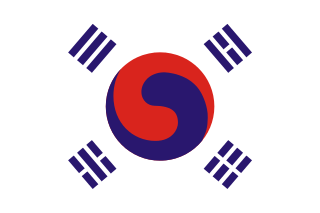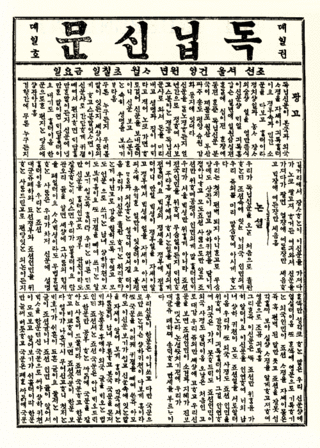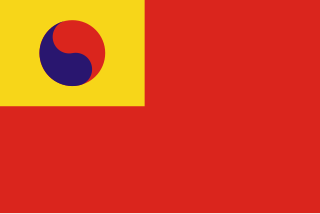
Syngman Rhee was a South Korean politician who served as the first president of South Korea from 1948 to 1960. Rhee is also known by his art name Unam. Rhee was also the first and last president of the Provisional Government of the Republic of Korea from 1919 to his impeachment in 1925 and from 1947 to 1948. As president of South Korea, Rhee's government was characterised by authoritarianism, limited economic development, and in the late 1950s growing political instability and public opposition.

From 1905 to 1945, Korea was ruled as a part of the Empire of Japan under the name Chōsen (朝鮮), the Japanese reading of Joseon.

The Korean Empire, officially the Empire of Korea or Imperial Korea, was a Korean monarchical state proclaimed in October 1897 by King Gojong of the Joseon dynasty. The empire stood until Japan's annexation of Korea in August 1910.

The practice of Christianity in Korea is marginal in North Korea, but significant in South Korea, where it revolves around two of its largest branches, Protestantism and Catholicism, accounting for 8.6 million and 5.8 million members, respectively. The initial variety of Christianity in the peninsula, Nestorianism, spread to Korea in the Middle Ages by way of China via Middle Eastern adherents to the Church of the East. Catholicism was first introduced during the late Joseon Dynasty period by Confucian scholars who encountered it in China. In 1603, Yi Su-gwang, a Korean politician, returned from Beijing carrying several theological books written by Matteo Ricci, an Italian Jesuit missionary to China. He began disseminating the information in the books, introducing Christianity to Korea. In 1758, King Yeongjo of Joseon officially outlawed Catholicism as an "evil practice." Catholicism was reintroduced in 1785 by Yi Seung-hun and French and Chinese Catholic priests were soon invited by the Korean Christians.

The March 1st Movement, also known as the Sam-il (3-1) Movement, was a significant protest movement in early 1919 by Korean people that called for independence from Imperial Japan and a stop to the forced assimilation into Japanese culture. It is also sometimes referred to as the Man-se Demonstrations. It is remembered as one of the earliest and largest protest movements for Korean independence, and remembered as a catalyst for future independence activities. Thirty-three Korean cultural and religious leaders issued a proclamation, supported by thousands of students and civilians in Seoul. There were over 1,000 demonstrations in many other cities. These were brutally suppressed, with Korean historian Park Eun-sik reporting about 7,500 killed and 16,000 wounded, and 46,000 arrested.

Seo Jae-pil, better known by his English name Philip Jaisohn, was a Korean American politician, physician, and Korean independence activist. He was the first Korean to become a naturalized citizen of the United States. He also founded the Tongnip Sinmun, the first Korean newspaper written entirely in Hangul.

The Korean independence movement was a series of diplomatic and militant efforts to liberate Korea from Japanese rule. The movement began around the late 19th or early 20th century, and ended with the surrender of Japan in 1945. As independence activism on the peninsula was largely suppressed by Japan, many significant efforts were conducted abroad by the Korean diaspora, as well as by a number of sympathetic non-Koreans.
Presbyterian Church of Korea (PCK) was a Protestant denomination based in South Korea; it is currently separated into many branches.

The Korean Provisional Government (KPG), formally the Provisional Government of the Republic of Korea, was a Korean government in exile based in China during the Japanese occupation of Korea.

Wilsonianism, or Wilsonian idealism, is a certain type of foreign policy advice. The term comes from the ideas and proposals of President Woodrow Wilson. He issued his famous Fourteen Points in January 1918 as a basis for ending World War I and promoting world peace. He was a leading advocate of the League of Nations to enable the international community to avoid wars and end hostile aggression. Wilsonianism is a form of liberal internationalism.
Choe Nam-seon, also known by the Japanese pronunciation of his name Sai Nanzen, was a Korean historian, political activist, poet, and publisher who was best remembered as a leading member of the Korean independence movement.

Tongnip Sinmun, also known by its translated title The Independent, was a historic Korean language newspaper published between 1896 and 1899. It was the first privately managed daily newspaper in Korea and the first to print editions written exclusively in Hangul.

Yun Chi-ho was a Korean politician. His name is sometimes spelled Yun Tchi-Ho, his art name was Jwaong (좌옹), and his courtesy name was Seongheum (성흠).

Maria Kim was a Korean independence activist during the period of Japanese colonial rule (1910–1945). Her birth name was Kim Jin-sang (金眞常) and she also went by the name Kim Geun-po (金槿圃).

The history of Japanese foreign relations deals with the international relations in terms of diplomacy, economics and political affairs from about 1850 to 2000. The kingdom was virtually isolated before the 1850s, with limited contacts through Dutch traders. The Meiji Restoration was a political revolution that installed a new leadership that was eager to borrow Western technology and organization. The government in Tokyo carefully monitored and controlled outside interactions. Japanese delegations to Europe brought back European standards which were widely imposed across the government and the economy. Trade flourished, as Japan rapidly industrialized.

The Korean National Association, also known as All Korea Korean National Association, was a political organization established on February 1, 1909, to fight Japan's colonial policies and occupation in Korea. It was founded in San Francisco by the intellectual scholar and Korean Independence activist Ahn Changho, and represented the interests of Koreans in the United States, Russian Far East, and Manchuria during the Korean Independence Movement.

Floyd Williams Tomkins Jr. was an American Episcopal Priest, and Rector of the Church of the Holy Trinity, Philadelphia in Rittenhouse Square for 33 years from 1899 to his sudden death in 1932. He supported the independence of Korea from Japan.

The First Korean Congress was convened by Philip Jaisohn in Philadelphia from April 12 to 14, 1919 in the Little Theater at 17th and Delancey Streets.
East Asia–United States relations covers American relations with the region as a whole, as well as summaries of relations with China, Japan, Korea, Taiwan and smaller places. It includes diplomatic, military, economic, social and cultural ties. The emphasis is on historical developments.

The Foreign policy of the Woodrow Wilson administration deals with American diplomacy, and political, economic, military, and cultural relationships with the rest of the world during the Presidency of Woodrow Wilson, 1913–1921. Although Wilson had no experience in foreign policy, he made all the major decisions, usually with the top advisor Edward M. House. His foreign policy was based on the messianic philosophical viewpoint wherein he imagined America had the utmost obligation to spread its principles while reflecting the 'truisms' of American thought.


















